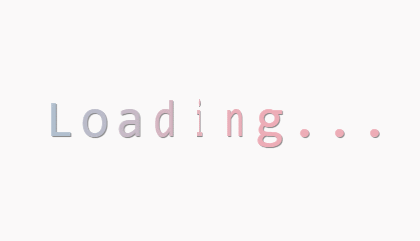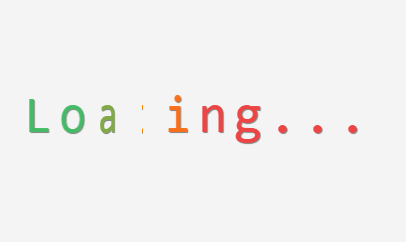이전 글 "CSS3를 사용하여 멋진 삼각형 배경 이미지 만들기"에서는 CSS3를 사용하여 멋진 삼각형 배경을 만드는 방법을 소개했습니다. 이번에는 CSS3 효과를 계속 공유하고 순수 CSS3를 사용하여 애니메이션 효과를 로딩하는 방법에 대해 알아보겠습니다~
웹사이트에 들어갈 때 많은 사진을 표시해야 하기 때문에 시간이 오래 걸리는 경우가 많습니다. 짐. 여기에 동적 로딩 효과를 추가하면 기다림이 지루해지지 않습니다. 예를 들어 아래 그림은 다음과 같습니다.
이 기사에서는 CSS3를 사용하여 얻은 두 가지 로딩 애니메이션 효과를 공유합니다. 두 가지 방법 모두 애니메이션과 @keyframes를 사용하여 구현됩니다. 구현 코드를 살펴보겠습니다.
첫 번째 효과를 얻는 방법:
<!DOCTYPE html>
<html>
<head>
<meta charset="utf-8">
<style type="text/css">
html,
body {
padding: 0;
height: 100%;
display: table;
margin: 0 auto;
font-size: 52px;
font-family: Monaco, Consolas, "Lucida Console", monospace;
background-image: url("http://subtlepatterns.subtlepatterns.netdna-cdn.com/patterns/kindajean.png");
}
.loading {
text-align: center;
display: table-cell;
vertical-align: middle;
text-shadow: grey 1px 1px 1px;
}
.letter {
float: left;
width: 35px;
height: 60px;
position: relative;
-webkit-animation: flip 2s infinite;
-webkit-transform-style: preserve-3d;
-webkit-transition: -webkit-transform 1s;
}
.letter div {
width: 100%;
height: 100%;
position: absolute;
-webkit-transform: translate(0);
-webkit-backface-visibility: hidden;
-webkit-animation: color 8s infinite;
}
.letter div.back {
-webkit-transform: rotateY(180deg);
}
.letter:nth-child(1),
.letter:nth-child(1) div {
-webkit-animation-delay: 0.125s;
}
.letter:nth-child(2),
.letter:nth-child(2) div {
-webkit-animation-delay: 0.25s;
}
.letter:nth-child(3),
.letter:nth-child(3) div {
-webkit-animation-delay: 0.375s;
}
.letter:nth-child(4),
.letter:nth-child(4) div {
-webkit-animation-delay: 0.5s;
}
.letter:nth-child(5),
.letter:nth-child(5) div {
-webkit-animation-delay: 0.625s;
}
.letter:nth-child(6),
.letter:nth-child(6) div {
-webkit-animation-delay: 0.75s;
}
.letter:nth-child(7),
.letter:nth-child(7) div {
-webkit-animation-delay: 0.875s;
}
.letter:nth-child(8),
.letter:nth-child(8) div {
-webkit-animation-delay: 1s;
}
.letter:nth-child(9),
.letter:nth-child(9) div {
-webkit-animation-delay: 1.125s;
}
.letter:nth-child(10),
.letter:nth-child(10) div {
-webkit-animation-delay: 1.25s;
}
@-webkit-keyframes flip {
0% {
-webkit-transform: rotateY(0deg) translate(0);
}
40%,
100% {
-webkit-transform: rotateY(180deg) translate(0);
}
}
@-webkit-keyframes color {
0% {
color: #88E488;
}
25% {
color: #EEADB7;
}
50% {
color: #90C9DB;
}
75% {
color: #F3B034;
}
100% {
color: #828282;
}
}
</style>
</head>
<body>
<div class="loading">
<div class="letter">
<div>L</div>
<div class="back">L</div>
</div>
<div class="letter">
<div>o</div>
<div class="back">o</div>
</div>
<div class="letter">
<div>a</div>
<div class="back">a</div>
</div>
<div class="letter">
<div>d</div>
<div class="back">d</div>
</div>
<div class="letter">
<div>i</div>
<div class="back">i</div>
</div>
<div class="letter">
<div>n</div>
<div class="back">n</div>
</div>
<div class="letter">
<div>g</div>
<div class="back">g</div>
</div>
<div class="letter dot">
<div>.</div>
<div class="back">.</div>
</div>
<div class="letter dot">
<div>.</div>
<div class="back">.</div>
</div>
<div class="letter dot">
<div>.</div>
<div class="back">.</div>
</div>
</div>
</body>
</html>위 코드에서는 먼저 두 개의 애니메이션을 사용합니다. 속성은 두 개의 애니메이션을 바인딩합니다. , 뒤집기 및 색상을 각 단어에 적용하여 뒤집기 동작과 색상 변경을 각각 제어한 다음 @keyframes 규칙을 사용하여 두 애니메이션의 각 프레임 동작을 설정합니다.
플립 동작은 요소에 2D 또는 3D 변환을 적용할 수 있는 변환 속성을 사용하여 제어해야 합니다.
효과는 다음과 같습니다.

다음 효과도 동일한 구현 아이디어이며 미묘하게 약간만 변경되었습니다.
두 번째 효과를 얻는 방법:
<!DOCTYPE html>
<html>
<head>
<meta charset="utf-8">
<style>
html,
body {
padding: 0;
height: 100%;
display: table;
margin: 0 auto;
font-size: 52px;
font-family: Monaco, Consolas, "Lucida Console", monospace;
background: #F5F5F5;
}
.loading {
top: 50%;
left: 50%;
width: 350px;
height: 60px;
font-size: 52px;
position: absolute;
text-align: center;
margin-top: -30px;
margin-left: -175px;
text-shadow: #808080 1px 1px 1px;
font-family: Monaco, Consolas, "Lucida Console", monospace;
}
.letter {
float: left;
width: 35px;
height: 60px;
position: relative;
animation: flip 2s infinite;
transform-style: preserve-3d;
transition: transform 1s;
}
.letter div {
color: #4B6;
width: 100%;
height: 100%;
position: absolute;
transform: translate(0);
backface-visibility: hidden;
animation: color 16s infinite;
}
.letter div.back {
transform: rotateY(180deg);
}
.letter:nth-child(1),
.letter:nth-child(1) div {
animation-delay: 0.125s;
}
.letter:nth-child(2),
.letter:nth-child(2) div {
animation-delay: 0.25s;
}
.letter:nth-child(3),
.letter:nth-child(3) div {
animation-delay: 0.375s;
}
.letter:nth-child(4),
.letter:nth-child(4) div {
animation-delay: 0.5s;
}
.letter:nth-child(5),
.letter:nth-child(5) div {
animation-delay: 0.625s;
}
.letter:nth-child(6),
.letter:nth-child(6) div {
animation-delay: 0.75s;
}
.letter:nth-child(7),
.letter:nth-child(7) div {
animation-delay: 0.875s;
}
.letter:nth-child(8),
.letter:nth-child(8) div {
animation-delay: 1s;
}
.letter:nth-child(9),
.letter:nth-child(9) div {
animation-delay: 1.125s;
}
.letter:nth-child(10),
.letter:nth-child(10) div {
animation-delay: 1.25s;
}
@keyframes flip {
0% {
transform: rotateY(0deg) translate(0);
}
40%,
100% {
transform: rotateY(180deg) translate(0);
}
}
@keyframes color {
1.5% {
color: #6AD;
}
3%,
12.5% {
color: #F80;
}
14% {
color: #4B6;
}
15.5%,
25% {
color: #F68;
}
26.5% {
color: #C83;
}
28%,
37.5% {
color: #96C;
}
39% {
color: #C83;
}
40.5%,
50% {
color: #E44;
}
51.5% {
color: #F80;
}
53%,
62.5% {
color: #4B6;
}
64% {
color: #F68;
}
65.5%,
75% {
color: #C83;
}
76.5% {
color: #96C;
}
78%,
87.5% {
color: #6AD;
}
89% {
color: #F80;
}
90.5%,
100%,
0% {
color: #4B6;
}
}
</style>
</head>
<body>
<div class="loader">
<div class="loading">
<div class="letter">
<div>L</div>
<div class="back">L</div>
</div>
<div class="letter">
<div>o</div>
<div class="back">o</div>
</div>
<div class="letter">
<div>a</div>
<div class="back">a</div>
</div>
<div class="letter">
<div>d</div>
<div class="back">d</div>
</div>
<div class="letter">
<div>i</div>
<div class="back">i</div>
</div>
<div class="letter">
<div>n</div>
<div class="back">n</div>
</div>
<div class="letter">
<div>g</div>
<div class="back">g</div>
</div>
<div class="letter">
<div>.</div>
<div class="back">.</div>
</div>
<div class="letter">
<div>.</div>
<div class="back">.</div>
</div>
<div class="letter">
<div>.</div>
<div class="back">.</div>
</div>
</div>
</div>
</body>
</html>효과는 다음과 같습니다.

다음은 애니메이션 @keyframes 및 변환의 세 가지 핵심 속성을 소개합니다.
CSS3 animation</ code> ( 애니메이션) 속성 <code>animation(动画) 属性
语法:animation: name duration timing-function delay iteration-count direction fill-mode play-state;
animation-name:指定要绑定到选择器的关键帧的名称 animation-duration:动画指定需要多少秒或毫秒完成 animation-timing-function:设置动画将如何完成一个周期 animation-delay:设置动画在启动前的延迟间隔。 animation-iteration-count:定义动画的播放次数。 animation-direction:指定是否应该轮流反向播放动画。 animation-fill-mode:规定当动画不播放时(当动画完成时,或当动画有一个延迟未开始播放时),要应用到元素的样式。 animation-play-state:指定动画是否正在运行或已暂停。
@keyframes 规则
使用@keyframes规则可以创建动画。创建动画是通过逐步改变从一个CSS样式设定到另一个。简单来说:@keyframes就是用来设置动画每一帧动作的。
@keyframes需要和animation 属性一起使用才能实现动画:
@keyframe规则由关键字“@keyframe”组成,后面接着是给出动画名称的标识符(将使用animation-name引用),随后是通过一组样式规则(用大括号分隔)。然后,通过使用标识符作为animation-name属性的值,将动画应用于元素。例如:
/* 定义动画*/
@keyframes 动画名称{
/* 样式规则*/
}
/* 将它应用于元素 */
.element {
animation-name: 动画名称(在@keyframes中已经声明好的);
/* 或使用动画简写属性*/
animation: 动画名称 1s ...
}CSS3 transform 属性
transform 属性向元素应用 2D 或 3D 转换。该属性允许我们对元素进行旋转、缩放、移动或倾斜。
语法:transform: none|transform-functions;